Compliance
Engineered to comply with the strictest enterprise information security and privacy requirements, Glance is the compliance-friendly enterprise visual engagement choice.
 |
ISO/IEC 27001 | Glance maintains annual compliance with ISO/IEC 27001. The certification and audit were performed by A-LIGN Assurance. ISO/IEC 27001 is a comprehensive security management standard that specifies a set of best practices and controls. It is an internationally recognized standard and means that as an organization, Glance has done the following:
This certification confirms our ongoing commitment to the security, confidentiality, and high availability of our services. It is important to understand that ISO/IEC 27001 is not a one-off audit. Instead, it is part of an ongoing process of continuous improvement, review and engagement with security standards and processes. |
 |
General Data Protection Regulation | The GDPR is Europe's regulation for data protection and privacy, but it also covers any data transferred outside the EU and EEA areas. As a result of Schrems 2, Glance utilizes Standard Contractual Clauses (SCC) for the legal and contractual movement of data. Our Privacy Policy aligns to GDPR requirements. |
 |
SOC for Service Organizations | Glance undergoes regular audits to ensure the requirements of each of the five trust principles (security, availability processing integrity, confidentiality, and privacy) are met and Glance remains SOC 2 Type 2 compliant. Glance's SOC 2 report extends to all Glance services. |
 |
Cloud Security Alliance | Glance is STAR Registry Level 1 with Cloud Security Alliance (CSA). The CSA Cloud Controls Matrix is a cybersecurity control framework for cloud computing. It is composed of 197 control objectives that are structured in 17 domains covering all key aspects of cloud technology. |